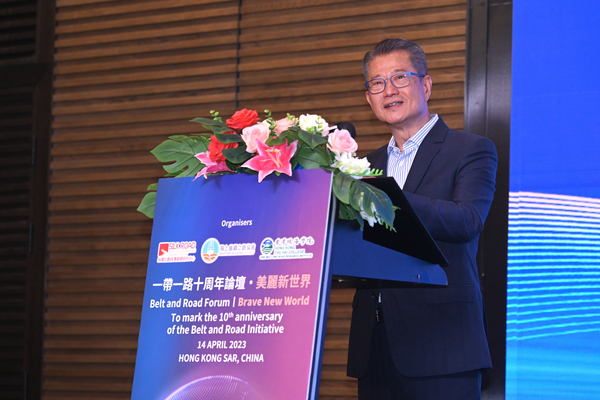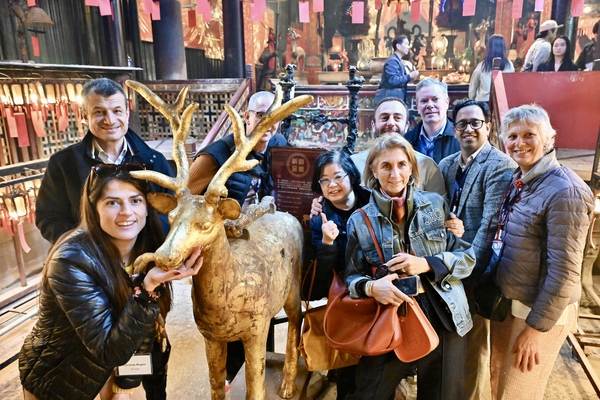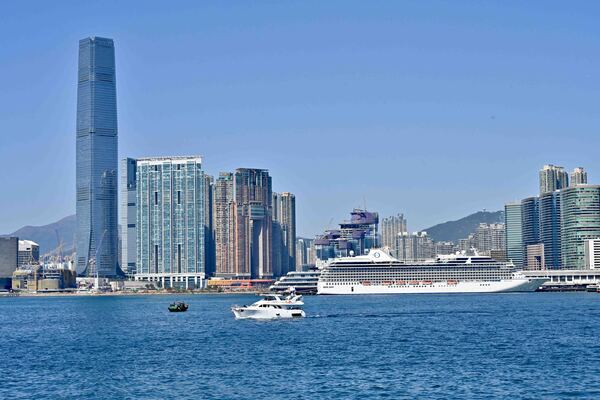BELT-ROAD BRINGS OPPORTUNITIES
14-4-2023
Alphabetical Index
依字母搜索

President Xi Jinping launched the Belt & Road Initiative back in 2013. This visionary initiative is built on connectivity - in infrastructure, trade, finance and people-to-people bonds - here in Asia to the Middle East, Africa and far beyond. Its goal is clear and clearly laudatory: the achievement of common development and prosperity for all.
Some 60 economies came together a decade ago in pursuit of that goal. But today, more than 150 countries and 32 international organisations have signed Belt & Road agreements with the Mainland. Collectively, they account for about 40% of the global GDP and 45% of the world's merchandise trade.
And let me add that with the rising economic importance of Asia and the centre of economic gravity shifting from the West to East, the future of the Belt & Road is all the more promising.
Economists are expecting that the 10 countries of ASEAN are on the way to become the fourth largest economy in the world by 2030. Meanwhile, the Gulf countries, amid high geopolitical tensions and the financial turbulence in Western economies, are also looking to this part of the world to diversify their investments. They are very keen on collaborating with us.
This cannot be more explanatory than the impressive progress of co-operation. The annual trade volume between China and Belt & Road nations has doubled since the initiative's inception, from around US$1 trillion in 2013 to more than US$2 trillion last year, with an average annual growth rate of 8%.
Last year, despite the challenging economic environment, China's Belt & Road non-financial outbound direct investment increased by 3.3% to about US$21 billion.
Increasing infrastructure connectivity among the Belt & Road countries is also bringing widespread benefits to participating economies.
Both Julia (Ms Julia Carlton, master of ceremony) and Regina (Mrs Regina Ip, Co-Chair of the Maritime Silk Road Society) alluded to the various mega infrastructure projects in Pakistan, in Southeast Asia and in Africa. I am not going to repeat them here, but they certainly signify some of the landmark initiatives set in motion by the Belt & Road Initiative.
HK’s roles
Hong Kong is a participant, contributor and beneficiary of the Belt & Road Initiative. Under the "one country, two systems" principle, Hong Kong serves as a key link, a central connector, between our nation and the world. We are, as well, a functional platform for the Belt & Road, blessed with advantages that can make all the difference for Belt & Road economies and companies.
That certainly includes our diversified financial and professional services offerings.
Hong Kong, after all, is a premier fund-raising platform. Aspiring for faster and greater development as well as higher quality of life, many Belt & Road countries have devised ambitious infrastructure development plans.
Green transformation is a common project as the world heads towards carbon neutrality. Estimates have suggested that the gap for green funding in Asia would amount to US$66 trillion in the next three decades. This is a huge funding gap.
Hong Kong is Asia's premier green fund-raising platform. Our green and sustainable debt arranged or issued reached more than US$80 billion last year. They included multi-currency issuances involving US dollars, Euro, renminbi and Hong Kong dollars, with various tenures of bonds up to 30 years.
Besides, in experimenting with the combination of fintech, blockchain technology and bond issuance, as well as increasing the efficiency of transactions, we issued the first ever government tokenized green bond in February this year.
What's more, Hong Kong also has strong greentech potential, where green start-ups with innovative technologies are already opening up their markets in the Belt & Road countries.
Synergising with the strengths of innovation in the Greater Bay Area, we see boundless potential for Hong Kong as a regional or even world green leader. That's why I have set out in my Budget to develop Hong Kong as an international greentech and GreenFi centre.
As Belt & Road countries re-centre their economic focus to the East, it can be expected that the use of renminbi (RMB) as a trading and reserve currency will rise. Given China as the world's second largest economy, the use of RMB has ample room to grow in light of the current very modest share of the currency in the world's cross-border payments and as reserve currency - both at the moment being less than 3% of the global total.
Hong Kong as the world's largest offshore RMB centre, and as a trusted international financial centre, stands ready to play an active role in the process, thus also helping with the internationalisation of RMB.
We are striving to enrich our RMB ecosystem and infrastructure and to roll out more products and risk management tools so that we will be able to address the investment needs of countries.
Our services sector is no less formidable, no less diversified. From feasibility studies and project management to architectural and engineering design, as well as legal services, risk management and many more, Hong Kong is the world's one-stop Belt & Road centre for professional services.
Connectivity boosted
We have already set off to revitalise and renew Hong Kong's links with the Belt & Road countries to capture the enormous opportunities ahead. That includes visits to ASEAN countries and the Middle East by the Chief Executive and other senior government officials since October last year.
Our mission, let me add, was rewarding for all concerned. For instance, in the Chief Executive's visit to the Middle East in February, 13 business-to-business MOUs and co-operation agreements were signed.
I am confident that more financial, commercial and trade co-operation, and collaboration, will follow.
Business and investment aside, we are equally keen to advance connectivity with countries, and communities, of wide-ranging cultural and ethnic backgrounds.
We are blessed to have the full support of our country in emerging as an East-meets-West centre for international cultural exchanges. Realising that goal will demand surpassing connectivity, and creativity, with our Belt & Road partners.
And that includes welcoming talent from Belt & Road countries to Hong Kong. I am pleased to remark that since the launch of our various new or upgraded talent admission schemes since last December, the response has been overwhelming. We are glad to note that today's Belt & Road Forum puts a spotlight on Belt & Road opportunities and on talent, as well - on enticing professionals from these countries to look to Hong Kong for their future.
Of course, we would be glad to see our people, particularly the younger generation, to explore their careers and opportunities in Belt & Road countries as well. That means more people-to-people exchanges and business opportunities for Hong Kong. No doubt, the forum today will consider how we can train, and retain, our own young professionals to help Hong Kong take full advantage of the promise that the Belt & Road offers.
Financial Secretary Paul Chan gave these remarks at the Belt & Road Forum: Brave New World on April 14.
PREVIOUSNEXT
Latest Business News
最新商業資訊
Virtual asset policy to be updated 7-4-2025

As a city where East meets West and tradition intertwines with innovation, we are proud to host you to collectively chart...
Six pre-sale consents issued in Q1 7-4-2025

The Lands Department issued six pre-sale consents for residential and non-residential developments in the first qu...
MICE tourism gains momentum 3-4-2025

Ballroom inspections and mahjong sessions may not be what automatically springs to mind when you consider Hong Kong’s ...
US reciprocal tariff rejected 3-4-2025

The Hong Kong Special Administrative Region Government today expressed strong disapproval of and discontent with the US�...